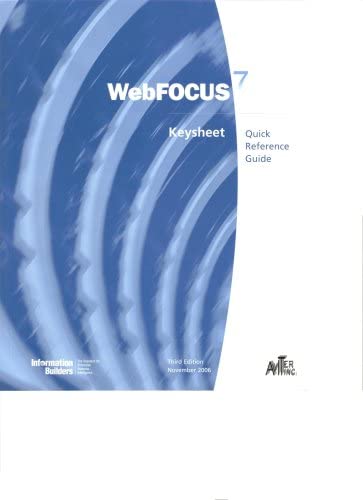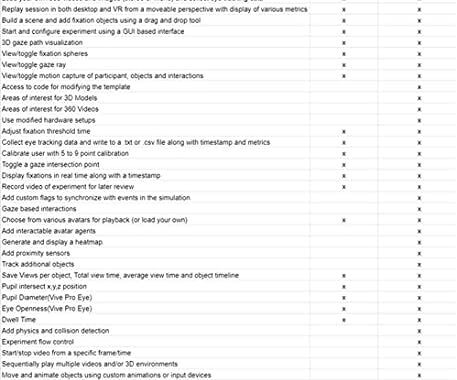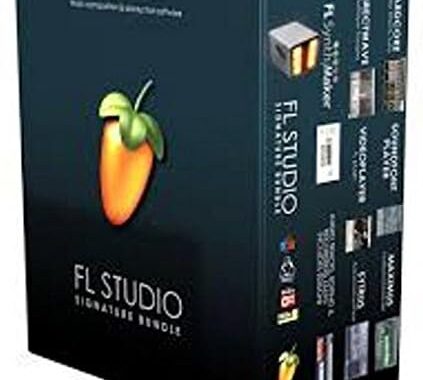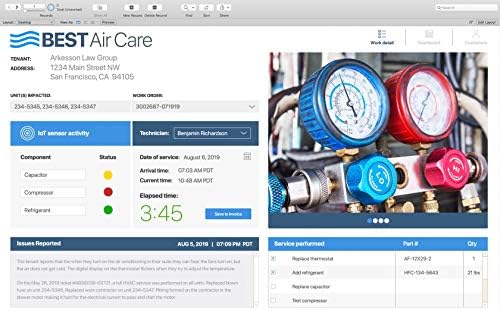Webfocus Keysheet Quick Reference Guide Review: A Comprehensive Guide to Boost Your Webfocus Skills

Webfocus is a widely-used business intelligence tool that is immensely popular. Individuals who wish to improve their Webfocus skills will find the Webfocus Keysheet Quick Reference Guide a great resource. This guide provides a detailed overview of Webfocus’ various commands and tips for optimizing your workflow. This review will explore the features and benefits of this guide for Webfocus users.
Overview
The Webfocus Keysheet Quick Reference Guide provides a quick reference guide that gives an overview of Webfocus programming. Mike Murach, a well-known expert in Webfocus programming, wrote the book. The guide covers many topics such as creating graphs and charts, working with databases, and defining reports. This guide is ideal for both beginners and professionals who are looking to learn Webfocus programming.
Table of Contents
The guide is divided into 13 chapters that each cover a specific topic related Webfocus programming. Here’s a quick overview of the table.
Chapter 1: Introduction to Webfocus Keysheet
This chapter gives an overview of the guide as well as explains its purpose. It also explains how Webfocus Keysheet Quick Reference Guide works.
Chapter 2: Defining Reports
This chapter covers the different report formats and formats that Webfocus offers. It also explains how you can use the DEFINE command for creating reports.
Chapter 3: Working with databases
This chapter gives an overview of the different database types that Webfocus offers. It also covers how to query and connect to databases in Webfocus.
Chapter 4: Displaying Data
This chapter explains how to display data in Webfocus. It also demonstrates how to use the DISPLAY command, which creates tables and charts.
Chapter 5: Formatting Data
This chapter explains how to format data in Webfocus with the FORMAT command. It also covers how to use different formatting options to improve the appearance of reports.
Chapter 6: Filtering Data
This chapter explains how to filter data in Webfocus by using the WHERE AND WITH conditions. It also explains how the SET FILTER command can be used to limit the data displayed within reports.
Chapter 7: Sorting Data
This chapter will explain how to sort data using SORT commands. It also explains how to sort data using multiple criteria.
Chapter 8: Aggregating and Grouping Data
This chapter explains how to group and aggregate Webfocus data. It explains how to use COMPUTE to calculate aggregate values, and group data into categories.
Chapter 9: Joining Data From Multiple Tables
This chapter explains how to join data from multiple tables with the JOIN command. It also explains inner and outer joins for linking data.
Chapter 10: WebFOCUS Reporting Techniques
This chapter covers various reporting techniques in Webfocus including drill-down reports as well as subreports. It also explains how to use MASTER FILE to create reusable queries.
Chapter 11: Developing Chart Reports
This chapter explains how to create chart reports using the GRAPH or MAP commands. It also covers how to customize charts and add legends and labels to them.
Chapter 12: Building Dashboards
This chapter explains how to create dashboards in Webfocus. This chapter explains how to use ACTIVE DASHBOARD to create interactive dashboards that allow users drill down into data.
Chapter 13: Advanced Techniques
This chapter explains advanced Webfocus programming techniques, including advanced formatting options and how you can create complex reports with the FOCUS language.
Content Quality
The Webfocus Keysheet Quick Reference Guide’s content quality is outstanding. The guide is well-organized with each chapter covering a specific topic in depth. The explanations are clear, concise, and the examples are easy to follow. The guide includes diagrams and screenshots to illustrate the concepts.
Benefits of using Webfocus Keysheet Quick Refer Guide
Webfocus users have many benefits from the Webfocus Keysheet Quick Reference Guide. It provides a complete overview of Webfocus’ various commands and features, making it a great resource for beginners interested in learning the basics of Webfocus programming. It also offers tips and tricks to optimize your workflow and improve the appearance of your reports. Professionals who wish to improve their Webfocus programming skills will find the guide a valuable resource.
Conclusion
Anyone who uses Webfocus in their job is going to find the Webfocus Keysheet Quick Reference Guide a valuable resource. It provides a detailed overview of Webfocus’ various commands and tips for optimizing your workflow. It is easy to use and well-organized, making it a great resource for both professionals and beginners. This guide is essential if you want to improve your Webfocus skills.

![Amazon.com: Band-in-a-Box 2019 Pro for Mac [Old Version]](https://www.coupondealsone.com/wp-content/uploads/2024/04/2O6e4Cw25Z6a.jpg) Band in a Box 2019 Flash Drive Review
Band in a Box 2019 Flash Drive Review  WorldViz SightLab Tracking Software Omnicept Review
WorldViz SightLab Tracking Software Omnicept Review  Math ACE Jr. Review: A Must-Have Learning Tool for Kids Ages 4-8
Math ACE Jr. Review: A Must-Have Learning Tool for Kids Ages 4-8  Review of Image Line Software Studio Signature Bundle
Review of Image Line Software Studio Signature Bundle  FileMaker Pro Advanced Review
FileMaker Pro Advanced Review ![Amazon.com: Punch! ViaCAD 2D/3D v12- For Mac [Mac Download] : Software](https://www.coupondealsone.com/wp-content/uploads/2024/04/YBusi9QdX6E2.jpg) ViaCAD v12 for Mac Review
ViaCAD v12 for Mac Review  Elevate Your Baking with the Stylish and Powerful Drew Barrymore 5.3-Quart Stand Mixer
Elevate Your Baking with the Stylish and Powerful Drew Barrymore 5.3-Quart Stand Mixer  Review of the Sterilizer Charging Wireless Certified Sanitizer
Review of the Sterilizer Charging Wireless Certified Sanitizer  DESTEK VR Controller Review
DESTEK VR Controller Review